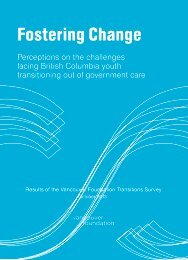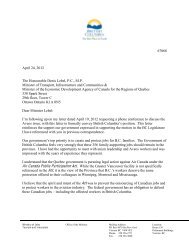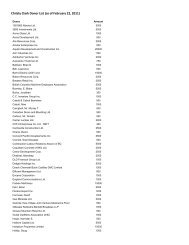from the ground up - The Tyee
from the ground up - The Tyee
from the ground up - The Tyee
Create successful ePaper yourself
Turn your PDF publications into a flip-book with our unique Google optimized e-Paper software.
<strong>The</strong> inside sheet of OSB will double as an all-woodvapour barrier. “This is our insulating and structuralwall,” he said. “We won’t penetrate it. No plumbing,no electricity <strong>the</strong>re.”<strong>The</strong> interior (2x4) wall would contain all <strong>the</strong> mechanicalsystems. “We won’t pre-insulate this. We can runall our plumbing, our wiring, anything else,” Duerfeldsaid. “When we finish <strong>the</strong> wall, just before we put <strong>the</strong>drywall on, we’ll insulate that as well.”Though it won’t include <strong>the</strong> sold-wood interior thatmakes <strong>the</strong> Lost Lake Passivhaus (nee Austria House)so visually attractive, Duerfeld’s affordable wall systemwill provide more insulation.“We have more R-value in this wall than <strong>the</strong> Austrianshave in that wall,” Duerfeld said. “Our philosophyis: We are going to show that you can do this usingCanadian products and Canadian labour.”In Germany, jobs grew quicklyIn <strong>the</strong> European Union, all new buildings must be“nearly zero energy” by 2020.“<strong>The</strong>y’re headed toward a Passivhaus-equivalentbuilding code. Your <strong>the</strong>rmal envelope is going tohave to be this good,” Duerfeld said. “I think that willslowly follow here, too.”Guido Wimmers is a Dutch architect who now worksas a designer in Vancouver. He wrote <strong>the</strong> city’s PassiveDesign Toolkit for homes, and he trains Canadianarchitects, builders and engineers through <strong>the</strong> CanadianPassive House Institute.“Quite a few European cities are already doing [Passivhausor near-zero building codes],” Wimmers said.“By 2020. A lot, actually.”Wimmers shares Duerfeld’s view that Canada is readyfor Passivhaus.“<strong>The</strong> time is right. LEED has sensitized <strong>the</strong> marketover <strong>the</strong> last few years. <strong>The</strong>y did an awesome job ineducating people. My personal opinion is just that<strong>the</strong>y have not focused correctly on energy, but itdoesn’t matter. Overall, <strong>the</strong>y have changed <strong>the</strong> buildingindustry,” he said. “Now, <strong>the</strong> market is open for<strong>the</strong> next big leap, for something more. And <strong>the</strong>y’veseen that Passivhaus is fairly successful.”Wimmers, who consults on numerous Passivhausprojects, expects to see between five and 10 more Passivhausbuildings in B.C. this year. “I could imaginethat a year later we are already at 50. And double that<strong>the</strong> following year.”He watched it happen in Europe.“<strong>The</strong>se ideas transformed <strong>the</strong> industry in a relativelyshort period of time,” he said, adding that <strong>the</strong> rate ofjob creation in Germany was staggering.“<strong>The</strong> automobile industry in Germany is huge, aseverybody knows. We’re talking about Mercedes,BMW, Audi, Porsche, Opal, Toyota, Volkswagen,” hesaid. “By 2008, <strong>the</strong>re were more jobs in energy-savingtechnologies and <strong>the</strong> renewable energy sector than in<strong>the</strong> whole German automobile industry.”Slouching toward PassivhausWimmers sits on a committee that advises <strong>the</strong> City ofVancouver on its plan to become <strong>the</strong> Greenest City in<strong>the</strong> world by 2020.He paused when asked whe<strong>the</strong>r he believed <strong>the</strong> cityshould adopt Passivhaus-like standards for its buildingcode.“Over time, yes,” he replied. “But I think <strong>the</strong> industryis not set <strong>up</strong> to accept this as a general rule by 2020.We cannot implement it over nine years. That’s toomuch.”In Europe, he noted, “<strong>The</strong>y’ve been working on thisfor 20 years.”Asked what he thought Vancouver should do to meet<strong>the</strong> green building component of its promise to reducecommunity greenhouse gas emissions by 33 percent (<strong>from</strong> 2007 levels) by 2020, Wimmers repliedpromptly and in detail.“First of all, push <strong>the</strong> code. Make it more challenging.So that legally allowed worst-case scenario? Just pushit a little bit higher. Raise <strong>the</strong> bar,” he began.51








